This is the only chicken stock recipe you’ll ever need. It’s an excellent all-rounder that’s nice and clear, with the ideal balance of flavour, nutrients and richness. Use it for everything from clear soups to rich stews, gravies and creamy sauces.
I like making chicken stock because it’s easy compared to beef stock, and improves just about everything – the main goal here!
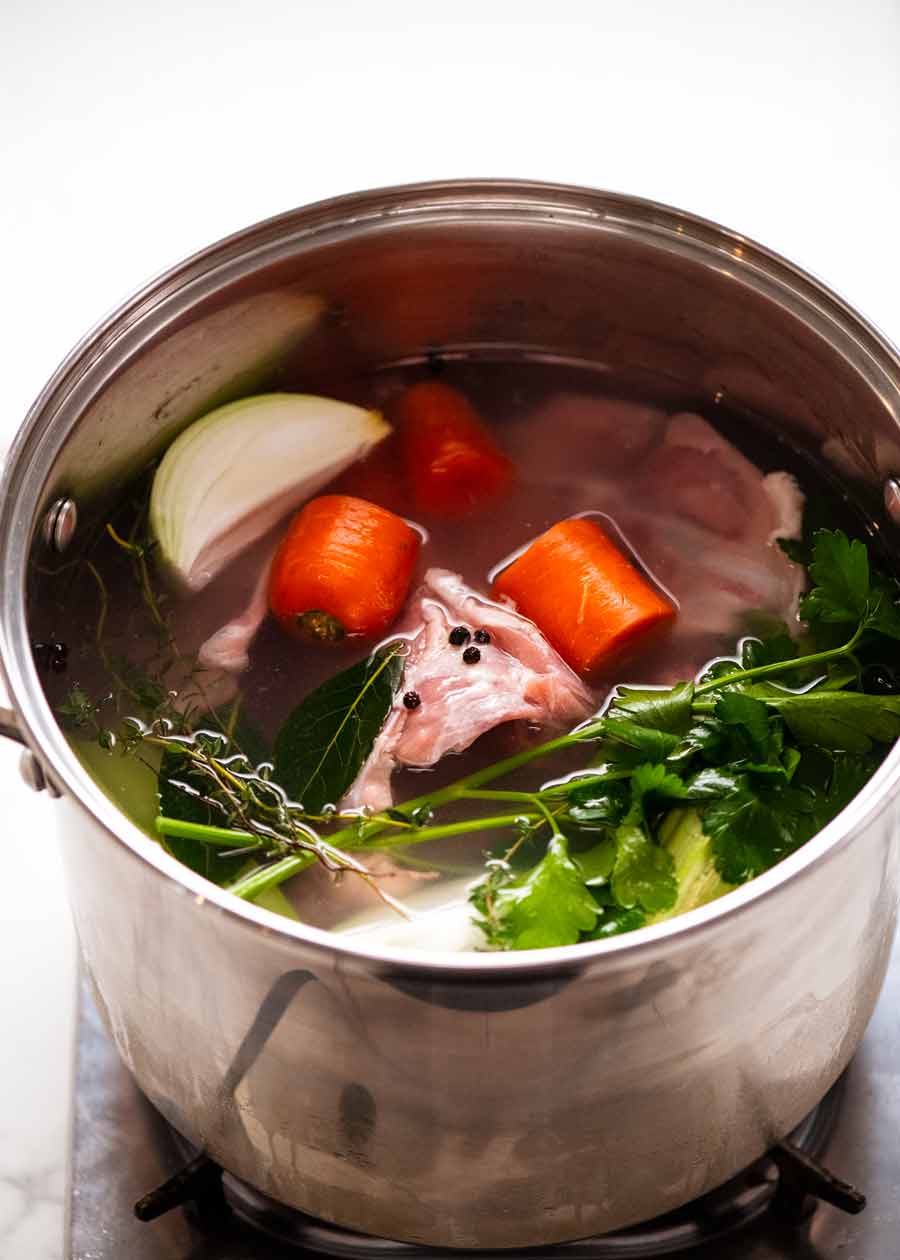
Chicken stock recipe
Stocks are the foundation for countless dishes in many cuisines. Chicken stock is one of the most common and versatile stocks in Western cooking, and is made by infusing water with the flavours of chicken, fresh root vegetables and herbs. Good restaurants always make their own stocks, and is the secret to why their dishes often have that richer, deeper, “restaurant-quality” taste to them!
If you’re not convinced why you’d bother making homemade chicken stock, let me persuade you:
Better flavour – Store-bought stock does not compare to real, freshly made stock. Just one taste is all you need to know this!
Richer mouthfeel – Homemade chicken stock has abundant gelatin from the chicken bones and tissues, which gives it a full-bodied richness and mouthfeel when used in soups and stews. Store-bought stock lacks this quality.
More versatile because it’s unsalted – Store-bought stock is almost always salted. This is fine when used at normal concentrations, but if stock is reduced a lot when making ragus, sauces and so on, the salt can become excessive – yet there is little you can do about it. Homemade stock on the other hand is unsalted, so you will never have this problem and can control seasoning in the finished dish.
Making jus and reductions – Fine dining reduction sauces such as jus rely heavily on the natural thickening power of gelatin to create that luscious, silky consistency. You can reduce a store-bought stock 90% on the other hand, and it will still be watery!
It’s surprisingly low-effort – While I’m the first to confess that beef stock does require commitment and lots of time to make (but it’s worth it!), chicken stock is much less maintenance. Just plonk everything in a pot and let it simmer for 3 hours, and strain!
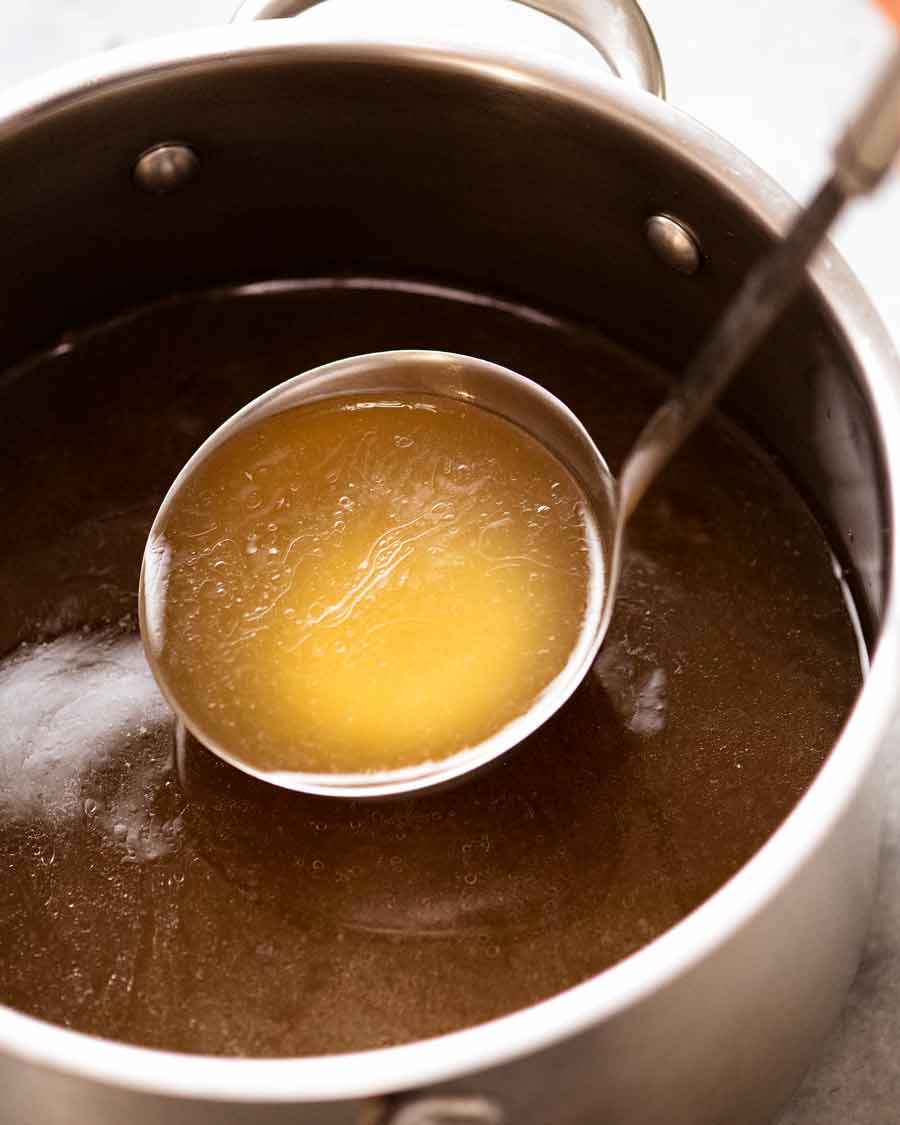
Bones for chicken stock
I use chicken bones to make chicken stock. I find that it makes a great all-rounder, clear stock with good flavour at store-bought strength. Specifically, I use chicken carcasses, also known as chicken frames, (see photo below) which litre for litre are the most economical cut.
What is a chicken carcass? A chicken carcass are the bones and cartilage “frame” of the chicken after all the meat has been cut off (breast, drumsticks, thighs, wings). There’s usually a decent amount of meat left on it, but it depends how nifty the butcher is with his knife skills! The balance of meat, bone and residual fat on a chicken carcass gives an excellent balance of flavour, valuable nutrients and collagen, as well as making a nice clear stock. They’re readily available here in Sydney from butchers and even grocery stores.
Some recipes will opt to use chicken pieces with meat and skin to make stock. I share my thoughts on this below! (Spoiler: I don’t agree!)
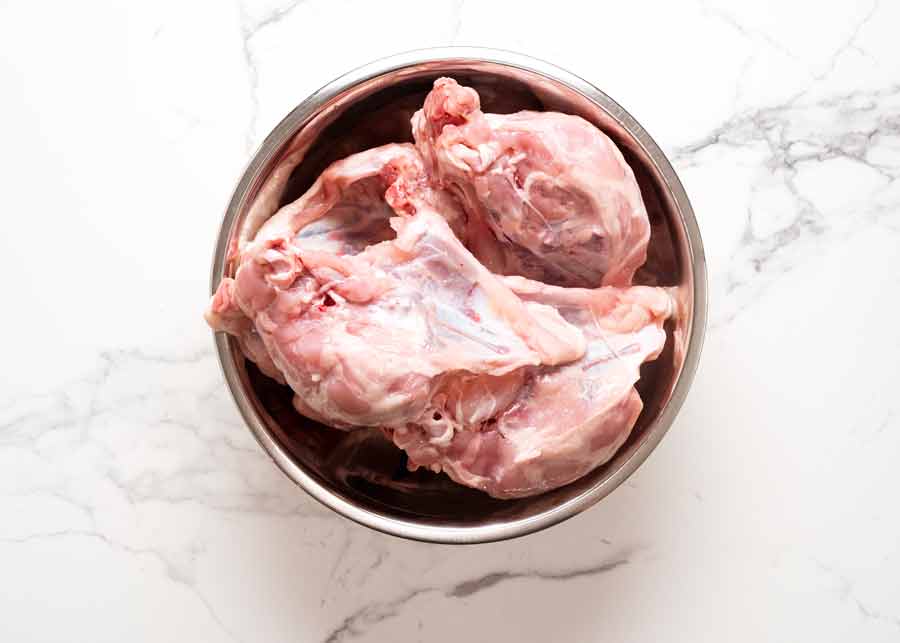
Why I don’t use other chicken cuts for stock
Here are my thoughts on other chicken cuts that are sometimes used for chicken stock:
Breast – I just think it’s wasteful. The cooked chicken is flavourless and stripped of all nutrition, because it’s given up all its goodness to the stock. So you can’t really use the spent meat for anything except maybe filler in strongly flavoured foods, or perhaps giving it to your dog! Also, because chicken breast is fairly neutral in flavour, you need a lot to extract enough flavour to make a decent stock.
Skin-on, bone-in chicken pieces, like thigh and drumsticks – While they make very flavourful stocks, the skin and fat makes the stock greasy and there will be quite a slick of oil floating on top of the stock. This is a little too fatty for many purposes, such as making nice clear chicken noodle soups.
Wing tips – Wing tips are packed with gelatin and flavour, being a dark meat. If you’ve got some, throw them in! But to make a whole batch of chicken stock, you’d need a LOT of wing tips.
Chicken feet – This will add a lot of gelatin into the stock so it wouldn’t hurt to throw some in (say 4 to 6) for extra richness. I think if you made a whole batch of stock using just feet it would be far too gelatinous!
Whole chicken – I find that you can’t extract enough flavour from a whole chicken for the amount of water required to cover it completely to make a proper flavourful stock. In fact, even when making a traditional chicken noodle soup using a whole chicken, I always add a small touch of stock powder to give the soup stock a little boost. Otherwise, it’s just a bit bland!
Giblets – Giblets refers to the heart, liver and gizzards of chicken that are sometimes bundled up and stuffed inside the cavity of store bought whole chicken. They are provided with the intention to make gravies and sauces. If you have some, by all means throw them in with the bones! I would not make a stock with just a big bag of giblets however, as it will be quite offal-ly!
Frame of cooked whole chicken – The carcass of a roast chicken will not provide enough flavour for homemade chicken stock. I’ve tried multiple times over the years! You just can’t get nearly enough flavour out of it for the amount of water required to cover it.
Vegetables and herbs for stock
Here are the other ingredients in homemade chicken stock:
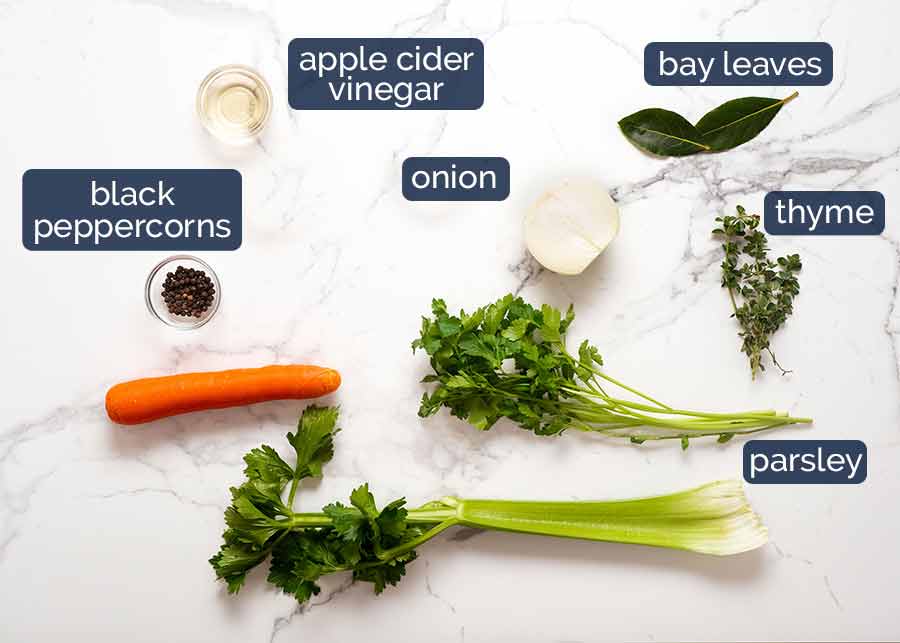
Bay leaves, thyme, parsley, black peppercorns – Herb and spice aromatics, a fairly standard selection for most stocks including beef stock and vegetable stock.
Onion, celery and carrot – Again, familiar building-block ingredients in most stocks and many Western dishes. The root vegetables add subtle sweetness as well as a freshness and complexity to the stock.
Cider vinegar – A little vinegar helps extract nutrients from the bone. We only use a splash, you cannot taste it nor does it make the stock discernibly sour at all.
Brown vs white chicken stock
A brown stock refers to a stock where the bones are roasted and the tray deglazed before simmering, as you would do with beef stock. A brown chicken stock has a deep, complex, roasted flavour as well as a darker colour.
A white chicken stock on the other hand simmers raw bones. The result is a cleaner, more neutrally flavoured and fresh-tasting stock that’s overall more versatile for cooking – versatile enough to be used even with seafood or non-chicken meat dishes, such as Fish Chowder. This is the type of stock that is mass produced and sold at grocery stores, and it’s the type of stock we are making today.
How to make chicken stock
Because we’re making a nice clear white chicken stock (see above), there’s no bone-roasting malarkey to take care of first which makes the whole process much quicker and less laborious. Just dump everything in a pot, add water and simmer!
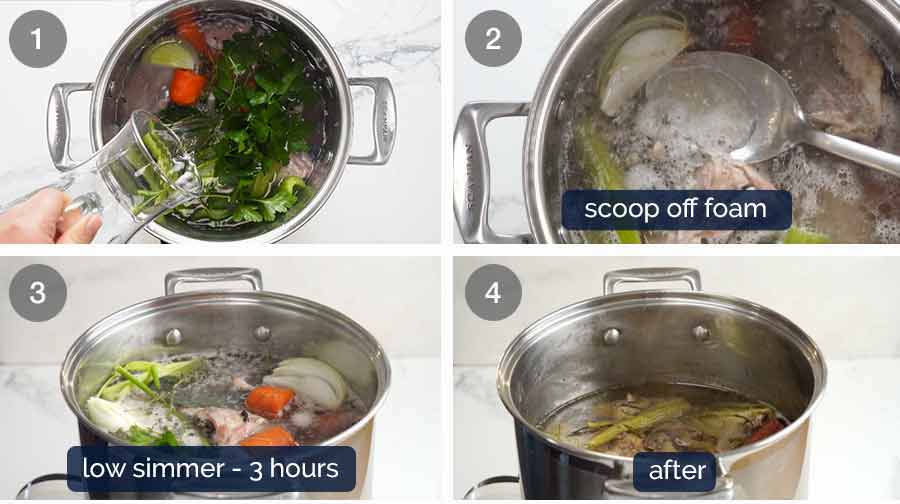
Put everything in a large stock pot – Place the chicken carcasses, vegetables, herbs and water in a large 7 litre /7 quart stock pot. 3 litres / 3 quarts of water should just about cover everything. If not, do a bit of pushing and poking to rearrange the carcasses and ingredients more snugly in the pot. Try not to break or crush the bones else this will make the stock murkier.
We want everything submerged so the water gets infused with flavour. Don’t worry if some of the bones are poking above the water surface. The carcasses will collapse once it starts cooking and end up under the water.
Scoop off scum – Bring the pot to a rapid simmer over medium-high heat. As it starts getting hot, you will see foam on the surface which is the impurities in the chicken. Scoop it off and discard to keep your stock nice and clear.
Simmer 3 hours – Once the water comes to a rapid simmer, lower the heat so it’s bubbling very gently. Then leave to simmer for 3 hours with the lid off.
After simmering – The photo above shows the water level after 3 hours. It has reduced by around 1/3.
Your chicken stock is done! Now we just need to strain it, remove excess fat (if you want) and store it! Here’s how:
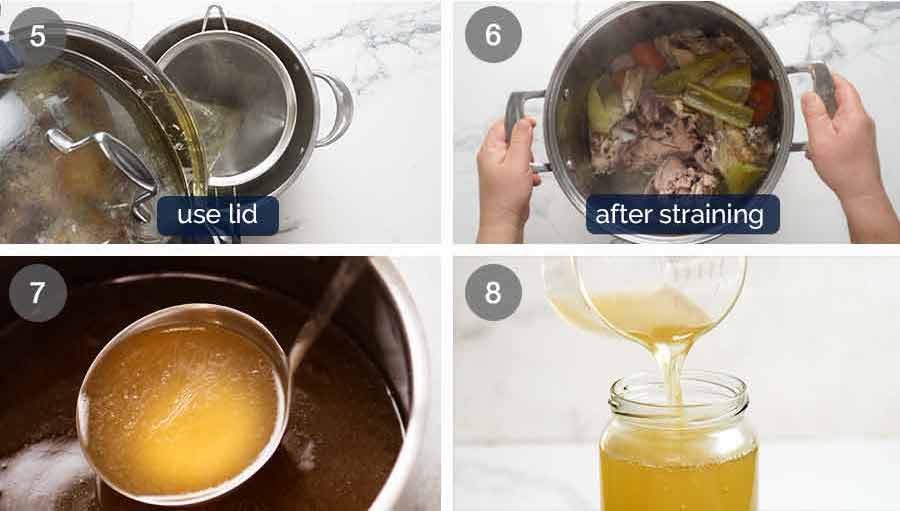
Strain – Using the lid of the pot to hold back the bones and vegetables in the pot, strain the stock through a fine mesh strainer into another pot or large bowl. I use a pot in case I need to reduce it to the right amount (see below)..
If you’re not strong or comfortable with the lid method, just fish out the solids with tongs or a large straining spoon before pouring the remaining liquid through a sieve.
The goal: To end up with 2 litres / 2 quarts of chicken stock. In a perfect world, you will end up with 2 litres / 2 quarts of chicken stock. But it is rarely a perfect world! And that’s ok. If you have less, than this just top up with water. If you ended up with more than about 2.25 litres / quarts, then reduce it on the stove, else you run the risk of a weak-flavoured chicken stock.
Leftover bones and vegetables – These have been well stripped of flavour and nutrition, so they aren’t really that useful. However, I do pick off excess meat for Dozer! But after that, I just discard the remnants.
Voila! Admire your beautiful and clear chicken stock!
Divide between storage containers – At this point, I divide the stock up into jars or containers which allows the stock to cool faster.
I store my chicken stock in 1 cup multiples which I find quite handy for use. Always label your containers with the quantity of chicken stock and date you made it!

Cool then refrigerate – Once the stock is cooled to room temperature, place them in the fridge to fully cool. Never put hot stock in the fridge!
Solidified fat – As the stock cools, the fat will rise to the surface. Once fully cold, the fat solidifies and turns into a white sheet of solid fat on the surface of the stock, like a frozen-over lake.
You will also notice that the chicken stock firms up into a jelly-like consistency when cold. This is due to the gelatin. We want gelatin – it’s what gives the stock a delicious, lip-sticking, rich mouthfeel you don’t get in store-bought stock (ever notice how store-bought stock never sets like this in the fridge?) So basically, jelly consistency = good stock!
Scrape off fat – Scrape the fat off the surface using a spoon and discard. This is actually an optional step. It makes the stock light and clean, making it a great all-rounder that can be used for everything from clear soups (like Chinese Noodle Soup) to rich sauces (like the sauce of a Creamy Chicken Pasta). For a jus or reduction sauces you should also use de-greased stock.
But if you are intending to use the stock for things like stews (like this one) and creamy sauces (like Mushroom Sauce) that do not require a clear, de-greased chicken stock like we desire for things like Chicken Noodle Soup, then there is no need to remove the fat.
Storing – Homemade stock will keep for 5 days in the fridge or for 6 months in the freezer.
Fridge-cold chicken stock can be used as is, in its jelly-like state. It melts back into liquid form very quickly as soon as it’s heated.
If using from frozen, thaw overnight in the fridge, microwave, or run the container under hot water to loosen, then melt in a saucepan. Though if I’m adding the stock into an already-simmering liquid sometimes I’ll just add the frozen stock block as-is! It melts fairly fast and the result is the same. I use all of these methods depending on how much time I have!
Here’s a jar of refrigerated chicken stock which has had the fat scraped off the surface.
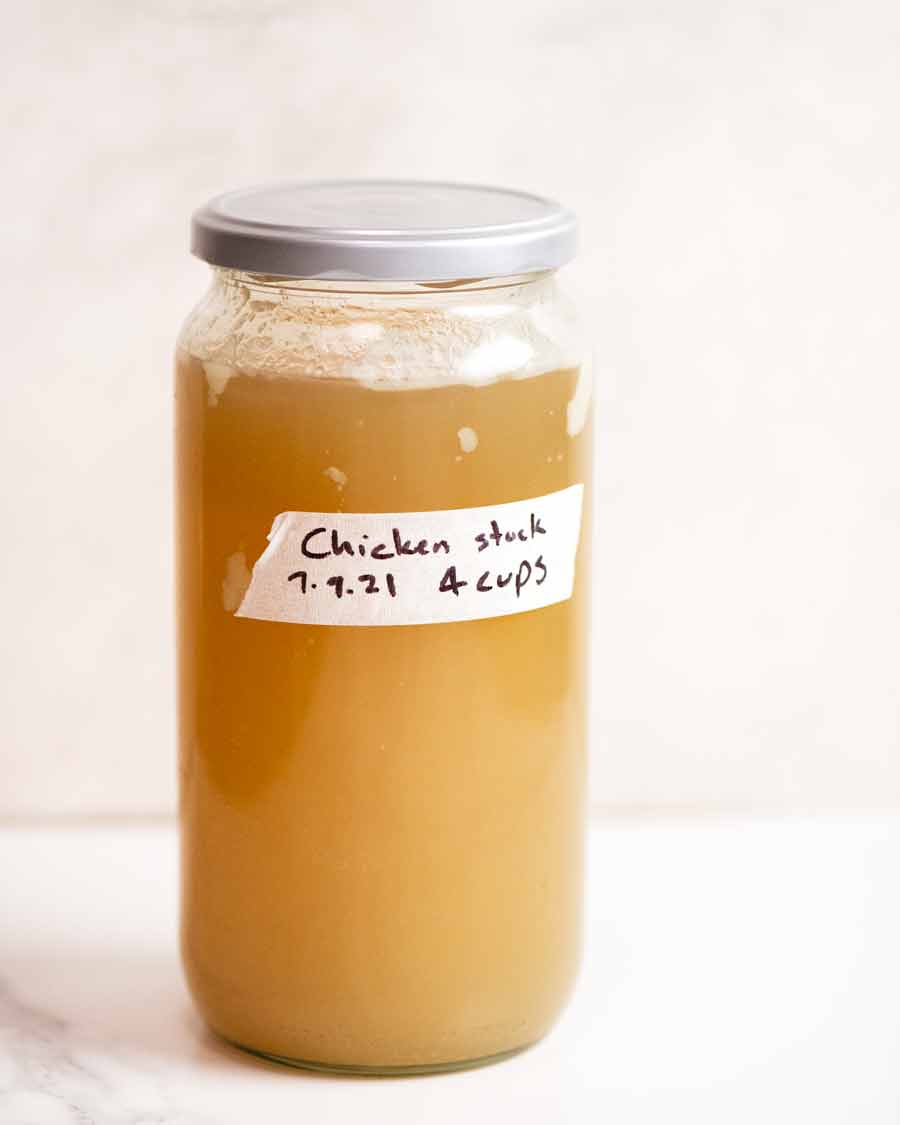
And here it is in liquid form at room temperature. But as noted above, you can just use chicken stock in jelly form as it melts in seconds on contact with heat!
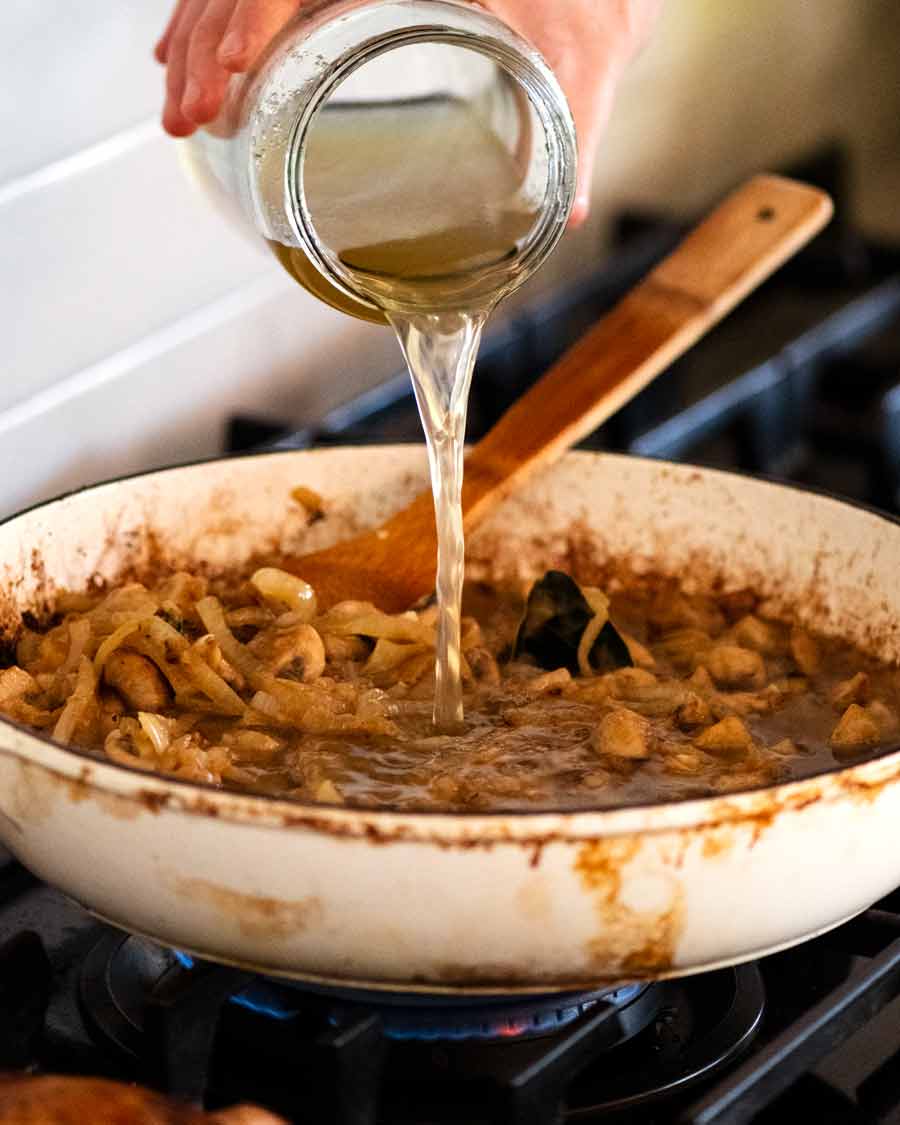
What to do with homemade chicken stock
This homemade chicken stock can be used for any recipe that calls for chicken stock. It will elevate any dish from great homemade food to top-notch, restaurant-quality in taste, believe me!
Homemade stock particularly makes a difference in dishes where the quality and flavour of the stock can shine. In other words, dishes that are not heavily flavoured with spices, seasonings or a heavy dose of cheese! Some ideas:
Rice dishes – Rice is a sponge for all that delicious stock in Mushroom Rice, Paella, Jambalaya and Oven-baked Chicken and Rice.
Clear soups – The pure flavour of the stock shines in Chicken Noodle Soup, Wonton Soup or Chinese Noodle Soup
Vegetable soups – It also gives real depth to simple vegetable soups, like Mushroom Soup, Minestrone, Pumpkin Soup, Leek and Potato Soup.
Stews and braises – Homemade stock raises any stew to restaurant-quality levels! Chicken is an obvious choice: Say Chicken Pot Pie, Chicken Tetrazzini or Chicken Stew with chicken stock. But chicken stock can equally carry other meats in a braise – Fish Chowder Soup or even Beef Bourguignon. And I actually deliberately use chicken stock over beef stock for Irish Guinness Stew, for better flavour.
Sauces and gravies – A world apart when made with homemade stock, whether it’s Turkey Gravy, Quick Gravy or a complete pan bake like Sausages with Potatoes and Gravy. Meanwhile a proper jus needs a proper stock, and this amazing Vermouth Jus can be made with chicken instead of beef stock.
On Wednesday, I’m going to be sharing a recipe that really benefits from homemade chicken stock. It’s great made with store bought, but when made with homemade, it takes it to company-worthy! – Nagi x
Watch how to make it
Hungry for more? Subscribe to my newsletter and follow along on Facebook, Pinterest and Instagram for all of the latest updates.
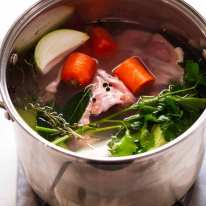
Chicken stock recipe
Ingredients
- 2 kg/ 4 lb chicken frames (ie carcass) , raw (Note 1)
- 1 carrot (medium), unpeeled, cut into 4 equal pieces
- 1/2 onion , peeled and halved
- 1 celery stem , cut in four (use the leaves too)
- 1/2 tbsp black peppercorns
- 1 tbsp apple cider vinegar (Note 2)
- 2 bay leaves , fresh (or 1 dried)
- 2 thyme sprigs (or 1/2 tsp dried leaves)
- 3 parsley sprigs
- 3 litres / 3 quarts water (just tap water, cold)
Instructions
How to make chicken stock:
- Fill pot: Place all the chicken stock ingredients into a large stockpot (7 litre / 7 quarts+). Fill with 3 litres / 3 quarts of cold water, which should just about cover the bones. (Note 3)
- Scoop off scum: Bring to a boil on medium-high heat. Scoop off and discard any foam that collects on the surface using a ladle (this helps make stock clear).
- Simmer 3 hours: Turn stove down to low and simmer for 3 hours with no lid. The stove should be low enough so the surface is barely rippling and you just get a gentle bubble every now and then. Too rapid boiling = murky stock.
- Strain: Using a lid to hold the bones and vegetables in the pot, pour the stock through a fine sieve into another pot or large bowl. (Alternatively, scoop out the solids first with a slotted spoon and then strain.)
- Goal: You should end up with 2 litres / 2 quarts of stock. If you have more than about 2.25 litres / quarts, reduce by simmering on low (else the stock will be too weak). If you have less than 2 litres / quarts, top up with water.
- Fill jars/containers: Measure out into containers for storage and faster cooling. (I do multiples of 1 cup)
- Cool: Allow to cool on the counter then refrigerate. This will make any fat rise to surface and solidify.
- Discard fat: Scrape fat off the surface and discard.
Storing and using:
- Ready to use! This stock is equivalent in strength to store-bought stock, so it can be used 1:1 in any recipe calling for chicken stock.
- Store for 5 days in the fridge or freezer for 6 months. (Note 6)
- Salt adjustment (Note 5): Homemade stock is unsalted whereas store-bought stock is salted. Add 1/4 tsp salt for every 1 cup homemade chicken stock (250ml) to match the salt level of store-bought low sodium chicken stock.
- To use: Cold stock has a jellied consistency (Note 4). It takes barely a minute to turn liquid on a medium-high stove, or microwave. You can also just add it in jelly form straight into dishes, but sometimes you may need to liquify it to measure.
Recipe Notes:
- the proportions of meat, bone and residual fat gives an excellent balance of flavour, valuable nutrients and collagen
- it makes a nice clear stock that is an ideal “all rounder”.
Nutrition Information:
Life of Dozer
He really believes in his heart that I made that mini strawberry cream cake just for him…..


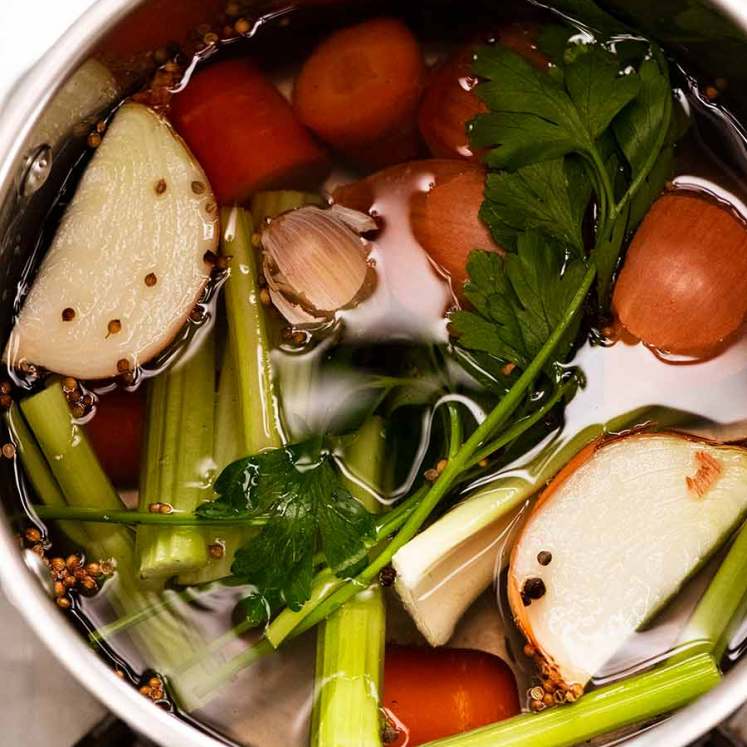
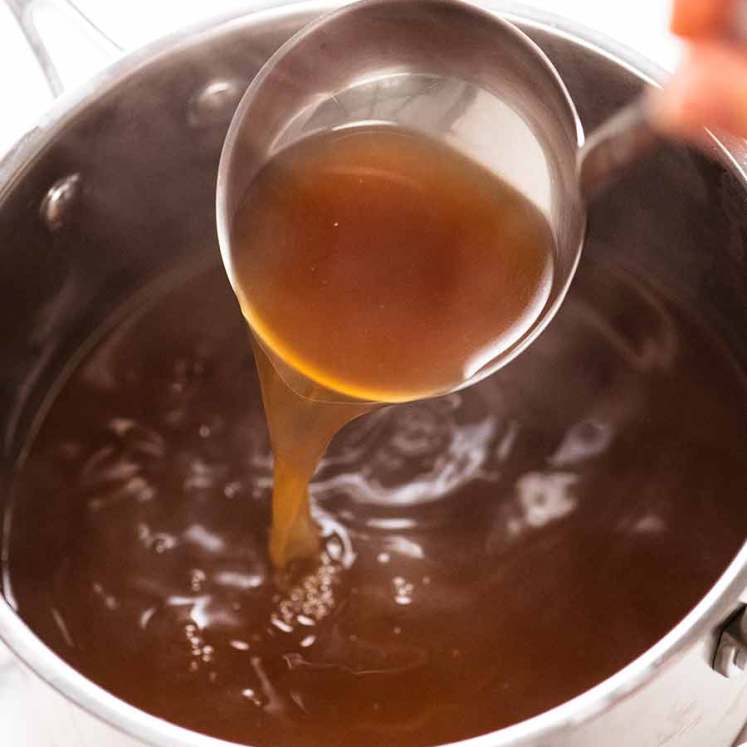
I make my chicken stock in my Instant Pot with 3 carcasses from Costco rotisserie chicken. I freeze the carcass until I have 3, then put them into the Instant Pot and let them cook for the maximum time. Then strain and freeze in containers. It’s like jello and so flavorful! I omit everything except the onion. I prefer just the chicken stock and will add herbs accordingly.
Sounds great Angie!! N x
Hi Nagi, I make chicken stock the same way except I add a few brown papery skins from an onion to the pot. They add a wonderful flavor and a richer color. Hugs to you and Dozer!
I love that everyone has their own variation – this is what makes cooking so great Jeani!! N x
I enjoyed reading this blog for chicken stock. I make mine in a pressure cooker. I use the same ingredients and bring to high pressure then cook at high pressure for 20 minutes. Then lower pressure by reducing heat and cook for 30 minutes. Turn off heat and let depressurize. The pressure helps ‘squeeze’ out the flavour from the chicken carcass and vegetables. It takes less time and is very good broth. And I use the meat to add to my chicken soup that I make from the broth.
Hi Barbara, I think if you were to then simmer the stock so it reduces and intensifies, you’ll have an even better flavour 🙂 N x
being a “golden” owner for many years, and in response to your karma post, i would have thought by now you would know the 3 major instincts of “goldens”,,, in order,,, FOOD, ATTENTION & LOVE,,,LOL!!! i am “goldenless” and i have never felt so alone so i really appreciate the Dozer pics and stories,,, oh and btw,, dont think i dont totally enjoy your recipes and techniques,,, with much admiration,
fred mohn, USA but willing to relocate to down under!!LOL
He totally steals the show Fred, they really are family ❤️ N x
Essential ingredient: Chicken feet…
You could add chicken feet if you like Yves, they aren’t commonly sold where I am located though! N x
Hi there, I’m very intrigued about this – chicken feet is sold everywhere here, I was staring at it when I asked the butcher for carcasses, which he didn’t have – so can I sub the carcasses with feet? I want to use this stock more as a broth for a sick family member
If I used only wings (a lot of them) would those make as good stock? Here in the U.S., at least where I live, I cannot get get raw carcasses.
Hi Natalie, can you get a mix of chicken bones at all? N x
Hi Nagi – I can get chicken backs – just found this out today, getting them tomorrow and using chicken wings as well, Should that work okay?
Yes perfect Natalie!! N x
I went through a chicken soup stage every week, chicken legs from Aldi or Coles 4/6 into stock pot with onion ,carrot, chopped roughly bay leaf cover with water , dont drown, bring to boil, skim off scum, simmer until meat is tender , remove meat and vegies, now you can choose to let liquid set overnight then skim any impurities , or add 250g of frozen stir fry vegetables, or more if you like, cook, reduce add thyme, salt to taste, any other spices you enjoy.
Cheap, flavourful, dog food after deboning , don’t bother using chicken meat yourself, flavour has all gone
Natalie, I use 1 whole chicken and 3 packages of whole chicken wings. It is has great taste and is gelatinous when cooled.
If you roast a chicken for Sunday dinner, take the leftover carcass and just use that for your broth. You can remove the pieces of chicken meat that are large enough to make sandwiches or use the meat in the chicken soup you would make from the broth. Even though the chicken carcass has been roasted that probably brings out flavour and you still get a wonderful broth. Also: I use vegetable ‘scraps’that are washed clean: you can use onion skins, the end part of the celery that you cut off to separate the stalks, I have even used carrot peelings. Just make sure they are well washed. They add flavour and you are not wasting anything!
Funny coincidence I made this exact recipe 2 days ago just before I read your email…..the only difference was I used verjuice instead of vinegar…I love this stock and use it for a base for wonton soup
Perfect Noeline!!! N x
great recipe Chef < I also like chicken necks and giblets and high protein hearts. "Good Appetite " with admiration Joseph !!
Sounds great Joseph! N x
Great recipe and hope to make this week.
Especially love Dozer with his tongue sticking out! Give that poor boy more treats.
Don’t worry, he gets his fair share 😉 N x
Great recipe, but then what did I expect?!
Since I process and feed my dog (Obewan KiBarber) a raw diet, when I want to make chicken stock, I buy an extra case (30lb) of chicken necks and/or frames, take a “stock-making” day and fill my freezer with 14/15qt of stock.
Hmmm, looks like I have one of those days coming up pretty soon.
A great idea Kris!!! Give your pup a big belly rub from me!!! N x
I had to smile when I saw your dog’s name. We had 2 goldens, one named Obi (Kenobi) and the other Jedi.
While this may sound weird, chicken feet are full of collagen. Where I live, they are extremely cheap, almost giving them away, and two along with the chicken frame make for a very good stock. I first heard this from a person commenting about saving the feet for stock and was intrigued.
That doesn’t sound weird at all! I love that tip! Thank you for sharing Joanne – N x
Hi Nagi, I always enjoy your recipes, even more so when they prove memorable right 😁 (I’m thinking carcasses).
I think you should give the pressure cooker a go when it comes to stocks, they cut time down by so much! And if you use an electric one, you can even leave home and be sure your kitchen will still be in one piece when you come back…
You can AE, but I find you’ll get a clearer stock being able to scoop off the scum and also reducing it by simmering produces a better, more intense flavour. N x
Hi Nagi, you’re right, I’d get clearer stocks, it’s just that I’m a harried mum of little ones (who love your recipes, by the way, I only cut the salt down by half and maybe the spiciness 😀 ). But I do simmer to reduce if the flavour isn’t strong enough.
*not memorable, just “me” (silly autocorrect!)
Barbara, you’re right, I’ve tried the vegetables and the meat after pressure cooking and they have no flavour whatsoever left in them, and the stock definitely has it all!
Elly, electric pressure cookers don’t reach the same high pressures as stove top ones, so I usually cook at high pressure for 40 minutes, then reduce if necessary, but I start off with less water as the pressure extracts more liquid from the ingredients. (I highly recommend Laura Pazzaglia’s Hip Pressure Cooking to understand how it all works.)
Hi AE
Don’t mind me asking. How long will you need if you’re using electric pressure cooker to make the stock?
Thanks.
I agree! I have a Fissler pressure cooker (smaller version) and make my stock in the pressure cooker all the time. It seems to ‘squeeze’ the flavour out of the chicken and any vegetables that are added for flavour. And takes no time at all. Less than an hour to get up to pressure then let cook at full pressure then turn down heat and cook for about 20 or 30 minutes. Turn off heat, let cooker rest until pressure is down and you have a wonderful inexpensive broth!
Thanks Nagi! I’ve thought about trying making stock a few times but never gave it a shot.
Could you use the carcass from a roast chook rather than a raw carcass?
Thank you! Xx
Hi Jess, I talk about this in the post above 🙂 N x
Awwwwwwww Dozer you are such a sweetheart I hope you got a little taste. 🤤😋😛🐾🐾🥧🧁💛💛
Always Carol 🙂 N x
Nice one Nagi, !
I make an almost identical version but in the pressure cooker, I have to say though I have never added parsley, will do next time!
Yep makes the best sauces and gravies, pressure cooker version takes 45 min. Fantastic work as always.
Hi Gazza, yes you can pressure cook, but also letting it simmer and reduce will give it a better, more intense flavour. N x
Thank you so much !! I’ve been really waiting for this stock recipe !!
I’ll make it this week.
Thank you Nagi
Love to know what you think Vic, make sure you let me know!! N x
Hi Nagi
Love your recipes. Just 2 questions with this one. Could this be made in a slow cooker on low heat? We have a plague of cockroaches and I hesitate to leave an uncovered pot for three hours for tehm to get into. Secondly, you decant into glass jars – can they be frozen? I would have thought they would crack. Take care, from South Africa.
Not this one sorry Dorothy, you need it simmering here. N x
I keep a baggie in the freezer for scraps (like corn-less cobs or carrot peels) and then add them to the pot. My mom taught me that the skin from onions add a beautiful color as well! We learned that from dying Easter eggs with natural ingredients when I was young.
Great tip Laura!! N x
Three suggestions.
1. Buy 18 drumsticks. Pull back the skin from the meat, and cut the meat away from the bone. No need to be fussy about this as leaving some of the meat on the bone is fine. The bones go in the stock (crack the bone with a cleaver to get access to the marrow if you like), and the meat is great for slow cooking.
2. Use a pasta pot, as this makes straining much easier: lift the pasta pot out of the stock and place over a bowl to drain, and the main pot is pretty much strained.
3. Do not throw away the fat you scrape off the top of the stock. This is schmaltz (rendered chicken fat), and is nearly as good as duck fat.
Cheers,
Mark.
You must be my brother from another mother because
(1) drumsticks are an easy answer if you can’t get carcasses
(2) pasta pot – big & easy to drain off the bulk, makes handling the rest so much easier and
(3) yes oh yes schmaltz is the BEST thing in the universe.
You could do that if you like with the drumsticks – it’s a little work so I would just prefer to buy the carcass! Love the idea of colander, although I don’t think I have one big enough to fit into my pot successfully! N x
Good tip on using the drumsticks there, I was trying to think what I could use as I doubt I can get carcasses near me easily. What do you do with the removed meat?
If I’m not going to cook it immediately, it goes into the freezer.
The meat is suitable for any recipe that calls for long, slow cooking. I usually use it in curries and tagines, but it would work in any slow cooked recipe that calls for chicken thighs such as Cacciatore or Apricot Chicken.
This is such a basic question, I’m almost embarrassed to asked it…but, when I think of “carcass” I think of a skeleton with little or no meat. Your photos look quite meaty, could you please tell me what your carcass is composed of? Thanks!
Hi Paula, not a basic question at all! It is a carcass, depending on where you get them from, some butchers will leave more meat on them than others. N x